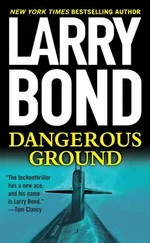Okun’s voice came over his headset. “Yuri, feet wet in ten minutes.” Tamir checked his watch. The strike was on schedule, to the minute. In ten minutes the lead plane would cross the Saudi coast and be over the Persian Gulf. That was also the Initial Point, or “IP,” technically the start of their attack run, although they were still hundreds of miles from the target.
Tamir checked the intrusion display again. All quiet. He patted the lieutenant’s shoulder. “It should be about thirty more minutes, Dvir. Then we’ll have some fun. These are not the planes you’re looking for.”
And if they did their job right, the Iranians would never even know they’d been hacked.
8 April 2013
0445 Local Time/0145 Zulu
USS Ronald Reagan (CVN 76)
Commander Tom “Heretic” Dressier, squadron commander of VFA-147, the Argonauts, waited patiently in his Super Hornet for the deck crew to move into position and ready him for launch. He’d elected to be the last in his squadron to launch, both because it gave him a few more minutes in the air, and so he’d know if any of his guys had trouble getting off the deck. Besides, his tactical displays were already up. Even with his radar safely off, the data link from Reagan showed him exactly what was going on.
Nobody ever lit off their radar on the flight deck. The microwave energy it put out would cook someone where they stood before they could even feel what was happening and get out of the way. But more than that, Reagan’s air group was launching “quietly,” with no radio or radar transmissions by any of the aircraft. They wouldn’t energize their radars or break radio silence until Taz said to.
The squadrons were taking off in reverse order, the Black Knights of VFA-154 went first, then the Argonauts’ sister squadron VFA-146 the Blue Diamonds, then it would be the Argonauts’ turn. Theoretically, each catapult could launch a plane every two minutes, and Reagan had four, two at the bow and two at the waist. That meant one plane every thirty seconds, but it all depended on the plane handlers and the rest of the flight deck crew.
Flight deck operations on a carrier have been called a “ballet.” Like ballet, it’s a precise art, and the performers on Reagan practiced and rehearsed it daily. But imagine the precision of a ballet combined with the noise and danger of a stock car race, where the stock cars are carrying high explosives. To complicate matters further, it was pitch black and the wind was whipping down the length of the flight deck at over forty knots.
Ready to launch, each Hornet weighed twenty-five tons, and was parked inches apart from the next. Almost any collision between two planes would render one or both unable to fly. The plane handlers had to move each plane in the proper order to its assigned catapult, line up the nose gear so the launch bar on the strut was engaged by the catapult shoe, and not get sucked into an intake or fried by an exhaust in the process.
Reagan’s flight deck crew was putting over fifty aircraft, a full deckload, into the air. Everyone would be flying in fifteen minutes.
A plane handler in a bright blue shirt ran over and stood in front of his aircraft, holding lighted wands so Heretic could see his arm signals. As much as it depended on the plane handlers, Dressier had to do his part, and follow their orders precisely.
Heretic released his brakes and gently increased power, taxiing past the other aircraft to the outboard port waist catapult. To the commander’s eyes, with his nose pointed toward the portside edge of the flight deck, it looked like the handler was going to put him over the side, but at the right moment the petty officer ordered the squadron commander into a hard right turn, almost pivoting on the right wheel. The Hornet ended up aligned perfectly with the catapult. The handler inched him forward, and he felt the catapult shoe engage the launch bar on his nose gear.
He had time to watch the plane ahead of him in the launch order — the last of the Argonauts except for him — spool up his engines to full afterburner and launch. Heretic watched the catapult officer, reflexively bracing his helmet against the seat behind him. He felt the nose of the plane drop as the catapult put tension on. Then he hit full burner, waited for the displays to settle, saluted the catapult officer, and grasped the handhold with his right hand. The computer would handle takeoff.
Heretic hardly noticed the blackness around him as he climbed to join his squadron.
8 April 2013
0450 Local Time/0150 Zulu
Over Western Saudi Arabia
For Colonel David Zohar, it was all about fuel. Everything else had been argued over, rehearsed, modified, and polished until there was precious little left to manage except the fuel.
Zohar commanded 69 Squadron, “The Hammers,” which flew the F-15I Ra’am, or “Thunder.” The squadron’s name was especially appropriate on this raid. Each plane carried a five-thousand-pound GBU-28 on the centerline, a monster weapon that could penetrate meters of rock and concrete. Each of his twenty-four aircraft carried one GBU-28, two smaller GBU-31s, two drop tanks, and air-to-air missiles for self-defense.
The formation had just finished in-flight refueling from KC-707 tankers, something that would have been impossible without Saudi permission. But thanks to their agreement, every plane would start their attack run with virtually full internal and external tanks. Even so, it might not be enough, if they had to use too much throttle, or had to deviate from the planned flight path, or suffered battle damage.
The tanker aircraft were hurrying back to base as quickly as their portly airframes allowed, where they would fill up again and take off to meet the returning planes. Recovery tankers have saved many pilots and planes, and the Israeli Air Force would go to great lengths to make sure everyone came home.
Reflexively, he scanned the horizon, then the sky above and below them. There was precious little to see from that altitude at that time of day. The lights of a few urban areas, especially farther west, glowed against the dark landscape below them, but there was nothing on the horizon and nothing above them.
His radar was off, his radio unused since he’d climbed in the cockpit. He didn’t need the radar or radio to navigate. Modern nav systems and GPS laid rails for them in the sky.
And he wasn’t blind. A Shavit electronics aircraft had taken off before them and surveyed the enemy defenses. A data link from the Shavit via satellite gave Zohar a complete tactical picture without having to send out a single electron. He could see the Iranian defenses, the American carrier strike group and its aircraft, surface traffic in the gulf, even Saudi fighters patrolling to the east if he wanted to expand his view.
Right now, he kept the displays centered on his route, studying the Iranians. In ten minutes he would begin to descend from thirty-five thousand feet down to five hundred feet, a carefully calculated downward slope designed to keep them below the horizon of the enemy’s radars.
But he wanted to stay at high altitude as long as possible. The Ra’am’s jet engines worked best in the thin air up high. At low altitude, they’d guzzle fuel at almost twice the rate, and the thick air also slowed them down. As long as they were undetected, he wanted to stay high.
Zohar’s back-seater was working the problem, but wasn’t helpful. “Colonel, I recommend we descend as planned. The hostile radars are performing as expected. If we push it now and are detected, they gain ten or even fifteen minutes’ reaction time. We might have to fight our way to the target.”
Читать дальше












